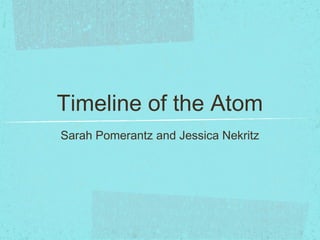
Atom project with sarah
- 1. Timeline of the Atom Sarah Pomerantz and Jessica Nekritz
- 2. Democritus’s theory was that there are minuscule things called atomos present in everything in the atmosphere, liquid or solid. Atoms cannot be split. Atoms have no specific size and can vary depending on factors.
- 3. Aristotle’s theory proposed that there are only four elements: earth, fire, air and water. Those elements smallest unit, atoms, made up everything on earth
- 4. Dalton’s theory proposed multiple ideas. He said that all matter was created with atoms, which cannot be made or destroyed. All atoms of the same element are identical, for example all water atoms are the same, but different elements are made of different atoms. When atoms are rearranged, chemical reactions occur. Compounds are made of atoms of the constitute elements.
- 5. theory? JJ Thomson discovered the electron, the negatively charged particle in an atom. He proposed that an atom is a sphere that is positively charged. Embedded within that sphere are the negatively charged electrons. Thomson and his assistant Francis Aston also discovered isotopes. Isotopes are atoms with different atomic weights.
- 6. Rutherford created the gold foil experiment to confirm Thomson’s plum pudding model. However the experiment proved that an atoms weight is not consistent throughout the whole thing but rather contained mainly in the nucleus. Based off of this discovery he developed the planetary model of the atom, with protons placed in the center of the atom with electrons rotating around the nucleus. This model has electrons rotating around the nucleus like planets rotating around the sun.
- 7. Bohr proposed that electrons had a fixed orbit around the nucleus. They move with a fixed size and energy. The energy depends on the size of the orbit and the smaller the orbit the lesser the energy. The atom is completely stable in the state of the smallest orbit. That lowest state is called the ground state. Electrons can jump from orbit to orbit by emitting or absorbing energy.
- 8. De Broglie suggested that rather than being in set orbits, electrons rotate around the nucleus in waves. He said that electrons could act as both particles and waves. An electron confined in an orbit around the nucleus has a specific wavelength, energy and frequency.
- 9. What was Heisenberg’s Theory? Heisenberg created the uncertainty principle. This stated that if someone wants to see an electron in orbit, one must shine a wavelength of light on it that is smaller then the electrons wavelength. The small wavelength of light has a very high energy which the electron will absorb. That energy will change the electrons position. He said that we can never know the momentum and the position of an electron at the same time.
- 10. What Was Shrodinger’s Theory? Shrodinger’s theory stated that electrons were in orbitals that were distributed throughout electron clouds. An orbital was defined by “the space that surrounds the nucleus in which two electrons can randomly move.” He stated that electrons cannot be given a direct position withing the atom and instead can be given probable regions. He also described four types of orbitals: the s, p, d, and f-orbitals.
- 11. Orbitals and Energy Levels
- 12. What was Chadwick’s Theory? Chadwick proved the existence of neutrons, uncharged particles in the nucleus of an atom.